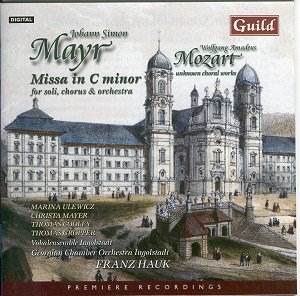Commissioned to write a work for the monastery of Einsiedeln,
Johann Simon Mayr submitted his Mass in C Minor in 1826. In a lively
and admiring exchange of letters Mayr was told that whilst undeniably
successful it was "perhaps too longÖand too scholarly" for
performance there. The monastery forces performed the work, though,
and the last recorded performance was in 1837. It is quite probable
that the work has lain unpublished and unperformed until this recording,
made in the Asam Kirche, Ingolstadt, not far from Mayrís birthplace.
It is in fact a fascinating work, reflective of a particular
cultural cross-fertilization between the German and Italian schools.
Its ethos is broadly Haydnesque but strong echoes of Mozartís late liturgical
works can be heard as can, remarkably, orchestral sonorities more associated
with Rossini and borrowings from Mayrís pupil, Donizetti. It was in
Italy that Mayr had first come to prominence, studying under Bertoni,
Director of San Marco, and writing the first of his operas. Mayr became
and remained until his death Maestro di Capella at Santa Maria Maggiore
in Bergano.
In the Mass Mayr adopted the Italian tradition of multi-movement
settings, which frequently entailed only one verse being set. Far from
limiting him it seems to have liberated his inherently expressive and
dramatic powers Ė this is an intensely involving work and the conclusion
of the Gloria, an allegro spiritoso of galvanizing effectiveness,
involves spirited violin writing, chirping Rossinian woodwind and a
choral climax of elegance and passion. It is only one of many felicities;
Et incarnatus est is an operatic aria in itself, with
the solo violinís filigree traceries, soloistsí and chorusí interjections
Ė though only the middle section is actually by Mayr; he borrowed the
rest from Donizettiís Credo of 1824, an unusual act of homage by Master
towards Pupil.
The superb fugal Hosanna in excelsis is all
Mayrís however and shows once more his technical gifts married expertly
to a sure dramatic sense. It is exceptionally short, at one and a half
minutes, but a Mass of this type is inherently short-winded and Mayrís
sureness of footing ensures that the work never sags or fractures. The
alto and tenor duet in the Agnus Dei is notable, not only for
its lyricism, but also for the orchestral writing which is always inventive,
imaginative and constantly alive. Mayrís writing for woodwind is memorable
for its soloistic colour and confidence and everywhere his dramatic
sense informs the score.
The soloists cope well with the Massís demands; they
are integrated into the fabric of the score with great skill and the
soprano Marina Ulewicz is the pick of the quartet.
As a pendant are three works by Mozart. The Salve
Regina is identical to the Benedictus from the Mass in C major and
appears as an appendix in the Koechel Catalogue. Quis te comprehendat
is an arrangement of the adagio of the Serenade for Brass K361 (370a)
Ė the choral arrangement tacked on is certainly not Mozartís own work.
In te Domine speravi is a revision of K505, A Scena con Rondo,
written for Nancy Storace, the first Susanna. It is expressively done
by Ulewicz who has to compete with a beefy organ part.
The Choir perform well and the chamber orchestra Ė
woodwind especially Ė particularly so. Praise too to Franz Hauk, who
shapes the Mayr into newly minted life. The sound is undistractingly
good and the booklet notes are tremendously informative and comprehensive.
Altogether this is a genuinely worthwhile discovery.
Jonathan Woolf
